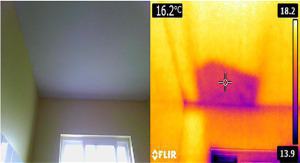Why use an infrared camera?
We use the latest Infrared Thermal Imaging Cameras, the FLIR E63900.
Infrared cameras are the latest technology being used for fast, reliable, accurate building diagnosis in a wide range of building problems, from evaluating Heating and AC systems, over-heated electric panels, missing insulation and moisture problems.
Several home inspection companies offer infrared services, but not all equipment is the same. We use the best high-end FLIR Infrared Thermal Imaging cameras. Just like any line of cameras, there are low end and high end. Our cameras provide better resolution which results in more accurate inspections.
How does Thermal Imaging work?
Thermography is the use of an infrared imaging and measurement camera to “see” and “measure” thermal energy emitted from an object. It is not a moisture meter, and does not “see” moisture. The cameras help the inspector see temperature differences and anomalies which can be caused by moisture. When two areas composed of the same or similar materials experience changing ambient temperatures, the area with the higher thermal mass (usually moisture) will change temperature more slowly.

The picture above shows a water leak behind the exterior siding of a home. Note the purple discoloured steak going down the right side. This is indicating moisture running down behind the exterior siding and possibly damaging the wall structure.
Evaluating a home with an IR Camera is a simple process, but one that most home inspectors do not do (The cameras are very expensive ranging from $1,000 – $10,000). And with many bank-owned homes getting a quick paint job for a fast sale, water stains may be covered up. It is important to note that the infrared cameras do not see through walls, cabinets, or concrete. Rather, they show differences in the surface temperature of a material. It is these temperature differences that may indicate moisture or another anomaly such as missing insulation.

The pictures above show an area that looked fine to the naked eye. After a quick scan with the infrared camera, you can see a void in the insulation above the shower in the bathroom. The insulation was moved to install the bathroom fan duct line and was never put back. This lack of insulation above the shower will now cause the ceiling in this area to remain cold which will cause any rising moist air to condense on the ceiling surface. This will cause water drops to form and possibly run down the walls damaging the surface and cracking the drywall joints. This was such a minor mistake, but had major consequences, which was only discovered with an Infrared camera.
Please note that an Infrared camera is not a magic tool. It cannot determine if a leak will occur in the future if the area has had time to dry out. For example, if there has been no rain for several months, the infrared camera will not detect moisture from a roof leak since no moisture is present. It also cannot detect moisture behind cabinets, furniture, or deep within a structure.
Thermal, or infrared energy, is light that is not visible because its wavelength is too long to be detected by the human eye. It’s the part of the light spectrum that we perceive as heat. Unlike visible light, in the infrared world, everything with a temperature above absolute zero emits heat. Even very cold objects, like ice cubes, emit infrared energy. The higher the object’s temperature, the greater the IR radiation emitted.
Infrared Before and After

An infrared camera allows us to see what our eyes cannot. The picture to the right shows a leak below an attic access door. This was a freshly painted “flip” house that looked perfect inside. The infrared camera helped find this leak by showing the inspector the dramatic difference in temperature. The purple dark area in the second picture shows the air leakage around the bottom of the door seal which increases heating costs for the home.
What Thermal Image Scanning is NOT?
MOISTURE METER – The infrared thermal imaging camera is NOT a moisture meter. It simply identifies thermal anomalies. This device greatly aids in identifying areas that need further investigation.
X-RAY VISION – The infrared thermal imaging camera is NOT an X-ray vision scope. It does not provide the user with an immediate Superman S on their chest with the ability to clearly see inside walls. Instead, it identifies thermal differences.
RISK ELIMINATOR – The infrared thermal imaging camera does NOT completely remove the risks of concealed damage.
PLEASE NOTE: It is deceptive to claim that thermal imaging detects moisture because the best that it can do is detect thermal differences. Using the infrared camera to help discover moisture issues is helpful because once the anomalies are identified then moisture meters and other diagnostic tools can be used to identify the source of the anomaly.
Moisture equals mould!
Moisture equals mould. Whenever a leak and moist conditions exists longer than 72 hours, then mould can form. This fact is a reality and the infrared camera can quickly and in a non-invasive manner, help identify these issues. But remember, the infrared camera identifies the heat signatures and does not measure the moisture content.
When moisture intrusion is located and corrected then further structure deterioration and widespread growth of mould can also be stopped. And even though thermal imaging inspections are expensive, they greatly help in the detection of structural damaging leaks. Please remember that every day that a leak goes undetected the damage is increased. When detected early the structural repairs and any needed mould remediation are significantly less costly.
When evaluating which inspection company to use for your home inspection, please consider this technology. Stinger Home Inspections uses Infrared Cameras at every inspection and each of our home inspectors is equipped with the latest technology. Isn’t your house worth it?